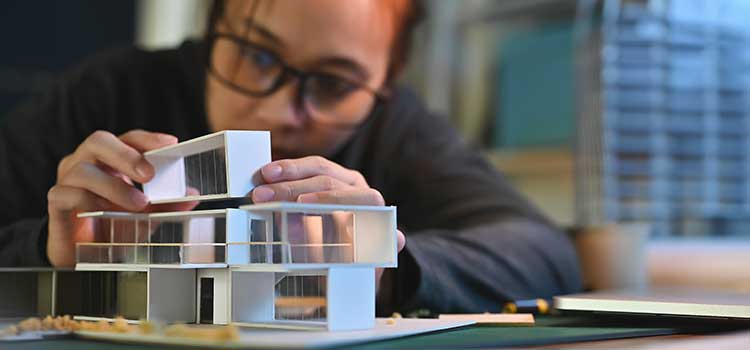Architect Salary Overview by Location and Experience
Recognizing the Diverse Job Paths Available for Aspiring Architect
As a hopeful Architect, you have a world of career paths waiting for you. Each path offers special difficulties and chances to use your creativity and technical knowledge. Whether you're drawn to typical style or the subtleties of sustainable layout, there's a niche that lines up with your passions. Recognizing these diverse alternatives can form your expert trip, but which instructions will you select to explore initially?
Standard Style: Designing Frameworks and structures
Standard architecture focuses on making structures and structures that blend functionality with aesthetic allure. Your styles can show cultural heritage, showcasing regional practices while satisfying contemporary requirements.
You'll establish abilities in drafting, model-making, and website evaluation, enabling you to picture and interact your ideas successfully. Engaging with clients, you'll need to comprehend their vision and translate it right into possible layouts.
In addition, constructing codes and sustainability techniques are important in your job, ensuring your frameworks are risk-free and environmentally pleasant. As you grow in your job, you'll find possibilities in property, business, and even restoration tasks, each offering distinct challenges. Accepting standard design leads the way for a fulfilling career that admires the past while shaping the future.
Urban Preparation: Forming Neighborhoods and Public Spaces
As an ambitious Architect, you can play an important duty as an urban planner, transforming just how neighborhoods operate and connect. By employing area engagement methods, you'll guarantee that homeowners have a voice in shaping their environment. Plus, incorporating lasting design concepts will certainly help produce spaces that not only meet today's demands but additionally safeguard the future.
Role of Urban Planners
While many could assume of designers as the sole dreamers behind buildings, city organizers play an important duty in shaping the wider landscape of areas and public spaces. By collaborating with numerous stakeholders, you'll assist develop parks, transport systems, and household locations that advertise social interaction and accessibility. Your competence in spatial design and area dynamics enables you to envision future development while preserving social heritage.
Neighborhood Involvement Strategies
Efficient area engagement methods are vital for city organizers to ensure that the voices of homeowners are heard and valued in the preparation procedure. To foster purposeful discussion, you must focus on open forums and workshops where neighborhood participants can share their concepts and problems. By actively integrating and paying attention feedback, you'll create spaces that mirror the area's requirements, inevitably leading to even more lasting and successful urban settings.
Sustainable Design Principles
When making city spaces, integrating sustainable style concepts is critical for producing settings that grow both environmentally and socially. Consider integrating green areas, like parks and gardens, to improve biodiversity and enhance air high quality.
Creating with water preservation in mind is additionally key-- consider rain gardens and permeable surfaces to take care of stormwater. Entailing community members throughout the preparation procedure guarantees that the rooms you produce fulfill their requirements and urge social interaction. By welcoming these concepts, you'll add to lively, lasting city landscapes that benefit everybody.

Landscape Design: Creating Sustainable Exterior Environments
As you discover landscape architecture, you'll find crucial design principles that develop useful and attractive outdoor rooms. Sustainable methods play an essential function in making certain these settings prosper while decreasing ecological effect. And also, you'll find a variety of job possibilities that allow you to make a genuine difference in exactly how individuals connect with nature.
Style Concepts in Landscape
Recognizing layout principles in landscape style is important for creating lasting outside atmospheres that integrate with nature. You'll need to consider elements like scale, percentage, and equilibrium to guarantee your designs feel cohesive and inviting. Incorporating native plants not just enhances biodiversity but also lowers water use, making your landscape resistant. Consider the flow of room and how people interact with it; paths and seating locations need to invite exploration and relaxation. Additionally, take note of seasonal adjustments, making with products that complement the surroundings year-round (Architect). By prioritizing sustainability and looks, you can produce exterior areas that enrich the area and promote well-being. Welcoming these concepts will certainly establish a solid structure for your job in landscape design.
Lasting Practices Review
Sustainable techniques in landscape style not just focus on appearances but likewise prioritize environmental wellness and source preservation. You can create spaces that promote dirt wellness, such as exercising and making use of natural materials permaculture concepts. Inevitably, these methods assure your Architect styles profit both people and the setting for years to come.
Profession Opportunities Exploration
With a strong foundation in lasting methods, landscape style supplies a selection of career courses that enable you to make a purposeful influence on the setting. Urban coordinators frequently work together with landscape architects to create green areas in metropolitan settings, enhancing city livability. If you're passionate regarding education, consider becoming a landscape architecture instructor, motivating future generations.
Lasting Layout: Concentrating On Eco-Friendly Practices
As you explore your profession in design, accepting green methods can establish you apart in a competitive field. Sustainable design concentrates on creating buildings that reduce environmental effect while boosting occupant wellness. By incorporating eco-friendly products, energy-efficient systems, and sustainable building methods, you'll add to a greener future.
Start by getting expertise of environment-friendly qualifications like LEED or BREEAM, which can bolster your qualifications. Take into consideration how natural light, air flow, and thermal efficiency can enhance design. Team up with engineers and environmental consultants to innovate remedies that lower waste and save resources.
Don't fail to remember the value of neighborhood involvement-- engaging local stakeholders can influence layouts that balance with the environment. As clients increasingly focus on sustainability, your navigate to this site proficiency in environment-friendly methods will certainly not just bring in projects yet likewise fulfill your enthusiasm for liable design. Welcome this important element of the profession, and view your profession prosper.
Historic Conservation: Protecting and Recovering Cultural Heritage
While you start on your architectural journey, take into consideration the important function of historic preservation in preserving our social heritage. This field concentrates on the protection and restoration of significant buildings, websites, and structures that tell the stories of our past. By taking part in historical conservation, you'll help guard the building heritage that shapes neighborhood identification.
As a historical preservation Architect, you'll evaluate historic relevance and analyze the condition of structures. You'll function closely with chroniclers and conservationists to guarantee genuine restoration methods are used. This job path permits you to mix creativity with study, enabling you to develop solutions that respect initial materials and workmanship.
Your job not only adds to sustainability by reusing existing buildings but additionally promotes a feeling of satisfaction within neighborhoods. Embracing this course will assist you come to be a guardian of background, preserving the stories and aesthetics that enhance our lives.
Inside Design: Enhancing Indoor Spaces
Historical conservation and interior style both share a dedication to boosting the constructed setting, however they focus on various elements. While historic preservation emphasizes preserving a framework's social and historic value, indoor design absolutely nos in on optimizing indoor spaces for performance and looks.
As an ambitious Architect, you'll locate that indoor design permits you to mix imagination with technological skills. You'll design areas that not only look excellent but additionally advertise comfort and effectiveness. This area involves comprehending just how light, color, and materials interact within a space, affecting mood and usability.
You'll deal with numerous jobs, from residential homes to industrial workplaces, guaranteeing that each setting satisfies the requirements of its residents. By prioritizing customer experience, you can transform insides right into motivating and practical spaces, making a significant influence on exactly how individuals engage with their surroundings. Welcome the opportunity to boost indoor environments and shape the method people live and function.
Industrial Layout: Combining Capability With Aesthetics
Industrial style plays an essential duty in developing items that flawlessly mix visual appeals with performance, making sure that what you use day-to-day is not just aesthetically attractive however likewise useful. As an aspiring Architect, you might engage yourself in this area, concentrating on creating whatever from furniture to consumer electronic devices. Your job includes comprehending individual demands, products, and manufacturing processes, enabling you to create innovative remedies that improve day-to-day experiences.
In commercial style, you'll typically collaborate with engineers, makers, and online marketers, ensuring that your designs are not only lovely but additionally possible. You'll discover to balance kind and feature, focusing on functionality without sacrificing style. By developing your skills in mapping out, 3D modeling, and prototyping, you'll be fully equipped to bring your concepts click resources to life. This career path uses a vibrant setting where creative thinking fulfills practicality, making it a gratifying choice for engineers thinking about shaping the products of tomorrow.
Regularly Asked Inquiries
What Educational Accreditations Do I Required to End Up Being an Engineer?
To become an architect, you'll need an expert level in architecture, normally a Bachelor's or Master's. Additionally, you'll have to finish an internship and pass the Architect Enrollment Evaluation to exercise legally.
Exist Certification Needs for Different Architectural Job Paths?
Yes, there're qualification needs for various architectural courses. Architect. You'll require to pass examinations, total teaching fellowships, and in some cases pursue specialized training, depending upon your selected focus, like landscape style, city style, or historical preservation
What Software Program Skills Are Crucial for Engineers Today?

How Can I Gain Practical Experience While Studying Style?
You can obtain useful experience by interning at architectural firms, joining style competitors, offering for neighborhood tasks, or working together with schoolmates on real-world assignments. These possibilities improve your skills and develop valuable connections in the industry.
What Task Opportunities Exist Outdoors Traditional Architecture Firms?
You can discover numerous task possibilities outside traditional design firms, like metropolitan planning, indoor style, landscape architecture, building management, realty advancement, and even duties in sustainability consulting. Each offers special difficulties and incentives.
Whether you're drawn to typical design or the subtleties of lasting layout, there's a particular niche that lines up with your interests.When making metropolitan spaces, integrating sustainable design concepts is crucial for producing atmospheres that thrive both environmentally and socially.As you explore landscape design, you'll uncover essential style principles that develop beautiful and useful exterior spaces.Comprehending layout principles in landscape style is necessary for producing lasting exterior environments that harmonize with nature.In commercial design, you'll typically team up with marketing professionals, engineers, and suppliers, ensuring that your styles are not just lovely yet likewise possible.